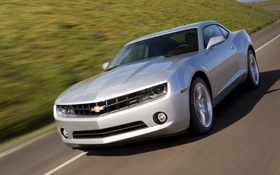2011 Chevy Camaro RS: Can You Have Your Cake and Eat It Too?

| Strong points |
|
|---|---|
| Weak points |
|
I can remember it like it was yesterday; it’s flat green paint looking distinctly haggard in the gleaming sun, the creased front fender leeching the rainbow hues of iron oxide down its flanks. Inside, the interior appeared to be unchanged since its creation in 1970, the familiar four speed shifter poking out of the ridiculously badly made faux-wood console. The two white rallye stripes, obviously someone’s attempt to personalize their particular car, looked fantastic against the once-gleaming hunter green paint; an interesting alternative to the all-too-common white-on-black theme that seemed to dominate the musclecars at my high school parking lot. But sadly, even in its forlorn and forgotten state, the 1970 Camaro Z28 that resided two doors down from my own childhood abode was never to be mine. But the seed had been planted, and before my 16th birthday I’d made sure to procure a Camaro of my own: a 1983 Z28.
Of course, saddled with a terrible 305 cubic inch V8 and automatic transmission, the car did little beyond educate me on the many, many faults mid-‘80s carburetion could possess while simultaneously trying to kill me on Vancouver’s wet roads. But I loved it just the same… except whenever I had to drive it past that ’70 Z28 that reminded me just what I had done: I’d settled.
And it was with this in mind that stepped towards the 2011 Camaro RS I was due to test. For years, I’d always seen the various V6 Mustangs and Camaros patrolling Vancouver’s streets and assumed that their various owners had merely settled for the slower versions of their selected steeds. However, after spending seven days aboard Chevy’s latest V6-powered Camaro, I can safely say that the six cylinder isn’t something one settles for, but rather chooses for any number of easily understandable reasons.
Powered by the same 3.6L direct injection engine found in last years’ car, the 2011 model delivers more power through increased efficiency, while maintaining fuel economy and lowering emissions, including a 25-percent drop in cold-start hydrocarbon emissions. It is standard on LS and LT models, producing 312 horsepower and 278 lb.-ft. of torque. Despite a compression ratio of 11.3:1, the 3.6L direct injection engine is designed to run on regular unleaded fuel. And although the fuel economy ratings of 12.3 L / 100 km (city) and 6.8 L / 100 km (highway) are certainly impressive enough, the real world fuel economy is quite surprising as well, with a week-long as-tested figure of just 11.9 L / 100 km. But perhaps most interesting is that no changes were made to the Camaro powertrain to achieve the higher horsepower ratings for 2011. They are based on additional testing that demonstrated the Camaro’s air intake and exhaust systems are less restrictive than the similar 3.6L DI engine on which the original rating was based.
From the first turn of the key, one can quite rapidly tell that the car’s V6 is a fantastic engine. With an exhaust note that’s probably best compared to a more refined, less synthetic sounding VQ exhaust note, the car quickly propels itself to extralegal speeds thanks to a pretty decent wave of torque, and once there, maintains forward momentum with a goodly amount of horsepower. The delivery is smooth and uninterrupted, and really had me begging for a proper six speed manual gearbox. However, the push-button Hydra-Matic six speed automatic did a good enough job of channeling the proper amount of power to the rear differential to preclude any real complaining.
But, that being said, there wasn’t a day that went by without a certain degree of regret. After all, seven days goes by pretty quickly when you’re enjoying yourself, and the low sticker price of the V6 really had me regretting the purchase of that old ’83 Z28. After all, if I’d invested that $2500 in something a bit more rewarding, there’s nothing saying that I couldn’t have ponied up the cash for a Camaro RS to call my own. Optioned out with a limited slip rear differential and the Aisin manual gearbox, my dream 2011 Camaro wouldn’t be an exercise in compromise, but rather a modern day Camaro Z28 lite. The high revving V6 produces more power than that old ’69 Z28 could boast of, and the combination of the relatively lightweight (V6’s weigh just over one hundred pounds less than their V8 brethren) package and tractable powerplant would certainly ensure a high degree of intrinsic corner carving ability. A lithe and economical alternative to the entertaining brute force supplied by the V8, the RS is a truly stupendous automobile, and deserves a lot more respect than many people, myself included, had given it. But, as I’ve learned, apparently you can have your cake and eat it too.











